
“I’M TRYING TO LEAVE IT BETTER THAN I FOUND IT”
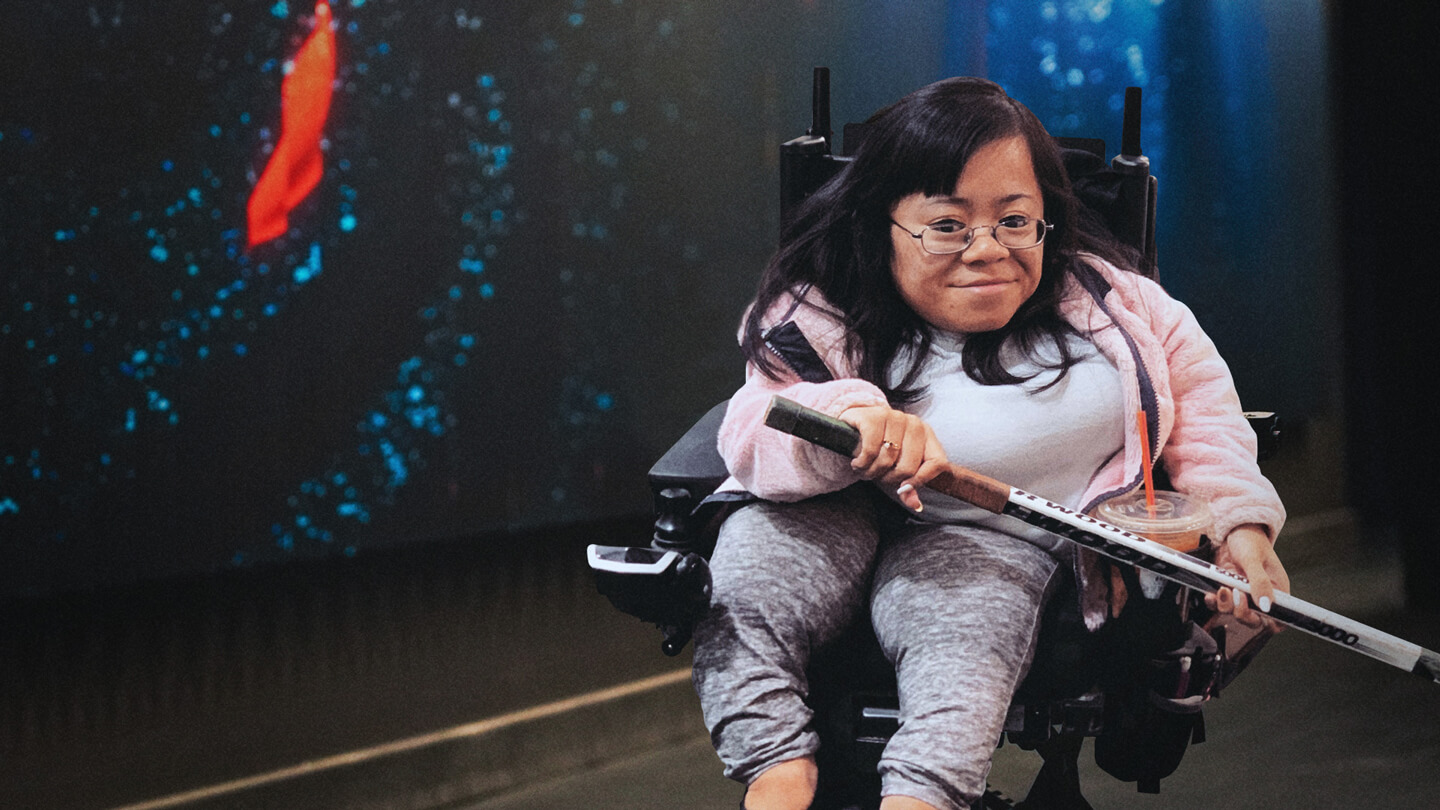
S
itting in a sunbeam with the crowd teeming around her, Chanel Keenan is taking it all in. It’s late June 2021, and a peculiar scene has enveloped Seattle’s Gas Works Park, its open lawns blanketed by rows of white folding chairs, by cameras and lights and video screens, by 4,000 locals on hand to witness a bit of history. The day’s itinerary is marked by the expansion draft that will populate the inaugural roster of the NHL’s 32nd franchise. And for Keenan, too, it’s a day of novel ascents.
To her right, two towering rust-red cylinders loom large, all manner of pipes, tubes, metallic hoses and wiry staircases winding around them — remnants of the old gasification plant that used to operate right here. Now, they sit like strange steampunk wallpaper behind banners emblazoned with Seattle Kraken logos. The scene in front of Keenan is something out of a grand theatre production. Two faux wooden planks rise from the stage on both sides to the steely rig of lights above, a third connecting them horizontally in the sky. Framed within them, past the podiums and video boards, she can see the boats on Lake Union. Further still is downtown Seattle’s skyline.
At stage left, a giant turquoise tentacle is frozen in place, fashioned to look like it’s emerged from the ground and plunged back in again. It continues at stage right, as if stretching underneath this presentation, shooting up from the earth and curling into the air high above the crowd. In front, a pretend buoy protrudes from pretend rocks. As if the moment wasn’t surreal enough, the giant marine diorama seems purpose-built to ensure this day loses all connection to the expected.
A camera crew waits at the ready a few feet from Keenan, embedded with her in the crowd. Former NHLer Dominic Moore kneels beside her, microphone in hand. In a moment, the voices on stage will introduce the two of them and the camera will begin broadcasting live to the half-million viewers tuning in. The anxious anticipation of this moment has wreaked havoc on Keenan. She hasn’t eaten all day, too preoccupied with trying to untangle the mess of nerves, excitement and gratitude that has been swirling since she was first approached about announcing one of the Kraken’s draft picks. But if inside she’s overthinking all the different ways this moment might play out, on the outside it doesn’t show. When the camera goes live, when Moore turns to her, Keenan appears calm and collected. She’s dressed in all black, the deep shade of her threads matching the sleek metal of her wheelchair. As she speaks, sunlight glints off her hoop earrings, bounces off bracelets and rings, touches the gems adorning her sandals.
Beside her, a group of young players from the local Western Washington Female Hockey Association are all smiles in red-and-white jerseys as Keenan looks to the camera for the main event. “From the Carolina Hurricanes,” she says, “the Seattle Kraken select… Morgan Geekie.” The crowd around her erupts. The list of names on the giant video board on stage grows by one. She exhales.
Brief as it might’ve been, the minute-long interaction on the national stage speaks volumes about Keenan’s ascent in the hockey world. Just a fan like any other in her Boston neighbourhood a few years ago, her fervent advocacy for the disabled community — for its members’ place in the hockey world and their voices in conversations about systemic change — has propelled Keenan into uncharted territory. In October 2020, she was hired by the Kraken to serve as the organization’s intersectionality consultant, a novel role in the pro hockey space. A year and a half in, the impact of her perspective — not only as a member of the disabled community but also as a woman of colour, as an East Coaster, as a social media afficionado, as one who adores the sport with limitless passion — has reverberated throughout the organization. But Keenan’s eyes remained fixed on the big picture, on the growth still possible beyond herself, beyond Seattle, beyond hockey. And staring down her first opportunity to affect real change in the game, she’s just getting started.
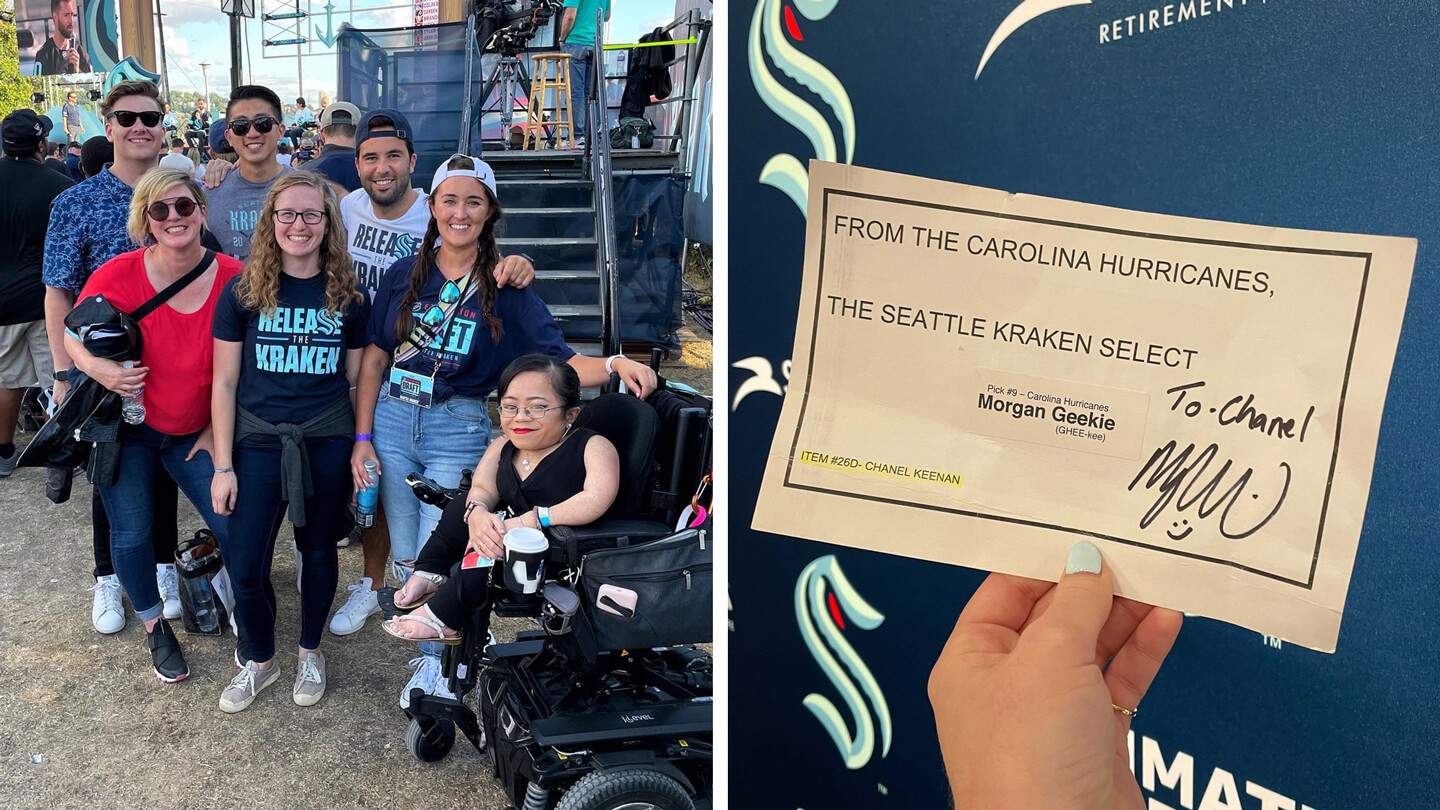
T
here’s a phrase Keenan turns to often when asked about her earliest memories of hockey — one that, for those familiar, captures all you need to know. “I would call myself a certified rink rat,” she says. “Growing up, I was around my brothers who were playing when we were younger. … They’re older than me, so I had to go to all their practices and scrimmages, all the tournaments.”
In Dorchester, Mass., that rink-rat status wasn’t necessarily a choice, just a part of life. Brothers Sam and Chris were suiting up for Dorchester Youth Hockey at the time, the same organization that helped mold local legends Jimmy and Kevin Hayes. Keenan, who was born with osteogenesis imperfecta and has utilized a power wheelchair since she was three, spent those familiar hours at the rink doing laps around the concourse with all the other young siblings. Had you caught up with her to ask during those pre-teen years, a life in hockey would’ve seemed far from her ideal plan. If anything, the hours on the road to and from games cooped up with the stench of sweaty equipment had her going in the other direction.
It was around 12 years old that things changed, that her gaze began lingering longer and longer when hockey came on the TV. In the end, she was pulled in by same thing that tended to snare many a kid around those parts: the glory of that black-and-gold spoked “B.” Before long, she was watching Bruins games regularly, getting invested in the names that graced their jerseys, structuring her homework schedule so she wouldn’t miss a single tilt. In that heyday of Boston sports, it didn’t take long for the dedication to pay off — the next year, 2011, the Bruins won the Stanley Cup. “That was kind of a good time to start paying attention to hockey,” she says with a laugh. Despite the banners and parades, the rest of the family’s interest in the sport waned. But for the household’s youngest, it only grew, until it became something more. Now, a decade on, ask Keenan about her Bruins fandom and she handles the subject with a grave seriousness — “I feel, really, just amazed that the universe let me witness Patrice Bergeron and David Pastrnak in the same lifetime,” she says with a reverence any Bostonian would respect.
The bridge from fandom to a career in the sport came in high school, when Keenan started working with her school’s athletic department. Running social media for the football team, then the women’s basketball team, she found an avenue that fit. But the path from Brookline High School to the big leagues was still hazy. Working in media seemed the best bet, so Keenan enrolled in the University of Massachusetts Amherst’s communications program.
Then, in her third year, everything changed.
Amid the early waves of the pandemic, a racial reckoning filled the streets and overtook the sports world in the process. When it enveloped the hockey community, Keenan found herself moved. She remembers reading Akim Aliu’s testimony, and those of other BIPOC players, and seeing the impact their stories had on fans who finally felt seen. It changed the way she viewed her own story, the way she understood the power of having a platform. “That alone inspired me to want to make a positive change, and to actually put things out there,” Keenan says. “So, in the summer of 2020, I, too, tried to participate and speak my mind.”
She penned a piece about the game’s flawed relationship with its disabled fans, about her vision for a hockey world that made space for all bodies, all abilities. She titled it, “Please, Remember Me.”
“I love a sport that feels like it doesn’t always love me back,” Keenan wrote. “…Fans of hockey come in all shapes, sizes and colours. That is something the leagues love to tell me. What I’ve noticed they tend to leave out is ‘ability.’ I am not asking that they tell me, I ask that they show me.” After pouring her soul out on the page, she put it up online and let it be, content in having spoken her mind. Fellow advocates like Black Girl Hockey Club shared the post. And on the other side of the country, one particular BGHC follower, Becca Elliott — who happened to be the Kraken’s director of digital and fan experience — was so moved by Keenan’s words, she couldn’t help but reach out to her.
“I thought the piece was so wonderfully candid,” Elliott says. “Talking about being a fan and adoring a game that she didn’t feel always loved her back, which I thought was a really profound statement, and one that felt grave for someone at 21 to be saying, as a college student.” She messaged Keenan to ask if she was comfortable with the piece being shared among the rest of the team’s front office — the ensuing conversation led to Elliott going straight to Kraken CEO Tod Leiweke with the suggestion that Keenan be hired by the organization. A request quickly greenlit when Elliott laid out the breadth of the impact she felt Keenan could have.
Leading the product and design teams for the Kraken’s mobile app, Elliott’s initial plan was for her new team member to advise the club on how to make the app as accessible as possible. But Keenan was thinking bigger. “One day I was like, ‘I need to do more. I have an ear in an organization that’s starting from scratch,’” Keenan says. “For someone like me, with such a unique background, I felt like there was going to be no better way to start something like this than with an organization that doesn’t have a huge history. … I had a conversation with [Elliott] and was just like, ‘I want to do more. You guys have a huge opportunity to really do something here. And I’d love to help.’”
By December, a month and a half after she was first hired, Keenan was taking part in a live virtual event hosted by the Kraken as part of its Disabled Hockey Week, the first she recalls seeing in her time as a fan.
“I want to be useful in the community,” Keenan says of her work with the organization, now a year and a half into her tenure. “I think when you’re born with a disability, sometimes there’s sort of this plan where some people like to go and talk about the disability and share and raise awareness on it as much as they can, and build foundations for it. And it can actually [become]their whole life. I saw that and was like, ‘How can I not do that necessarily, but shed light on a community that isn’t embraced in the traditional way, in hockey?’
“‘I know I can’t be the only disabled fan of this sport. There has to be more.’”
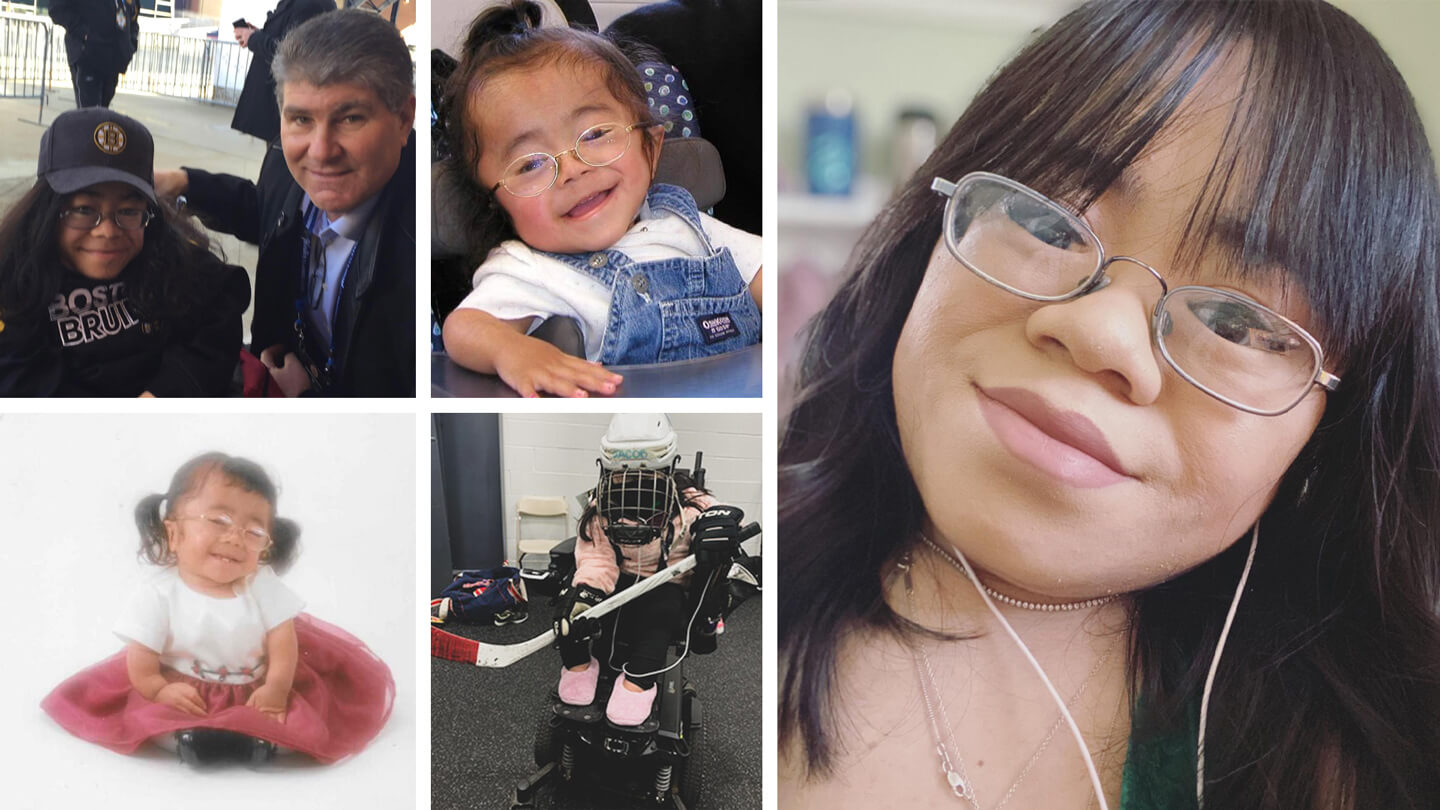
I
t’s safe to say Keenan has gotten her wish. Eighteen months into her run with the Kraken, ‘useful’ vastly undersells her contributions. The 23-year-old’s had a hand in seemingly everything the club does off the ice — how it represents itself online, how it treats its fans offline, how it trains staff internally, how it reaches outside its walls to the Seattle community. “It’s basically just assisting the club in all areas possible, through the lens of a disabled fan and an employee experience,” she says of her role. “It really is a lot of areas. I pretty much touch everything — other than things to do with numbers. Because I’m bad at math. I would not trust me around anything of that nature.”
For Elliott, the way Keenan’s perspective has reshaped the club’s communication with its disabled fanbase has been key. “Where she’s been able to make an impact already, very clearly, is certainly with the app and accessibility,” Elliott says. “Everything from captioning our posts both on social and the app whenever possible, to how we thought about our Frequently Asked Questions and navigating the arena and guest services, and how guest services can better approach our fans who are disabled or might have a need for special services in the arena. She’s been formative there.”
It’s that last aspect that’s expanded Keenan’s impact beyond online accessibility and into the brick-and-mortar, to how the club understands the experience of its disabled fans on game night. “Chanel brings a wonderful voice to that,” says Jacque Holowaty, the Kraken’s vice president of employee and guest experience. “For all of us to kind of think: How do people experience events differently? And how do we make sure, even if their experience is different, it’s still innately as equally exciting? What can we do that maybe we weren’t doing, where people had to kind of feel that things were being worked around versus that they could just show up to a game and experience it like everybody else? So, we worked on a lot of just how people enter our facility. And then, what is it that they’re looking at? How do they move around?”
It’s in those seemingly mundane, routine moments on game nights where inaccessibility tends to rear its head — buildings built for one type of body, experiences envisioned for one type of fan. But the solutions are often simple, and the simplest, of course, is having members of the disabled community at the table when those buildings are being planned, those experiences choreographed. For Holowaty, Keenan’s presence has been essential in reshaping how the team thinks about its space and the everyday goings-on within it.
“Chanel brought some really great ideas to the table,” says Holowaty. “You know, people that have mobility issues, getting food from stands, it’s hard because they don’t really have a tray to balance it on, to [take]it back, if they have to use their hands with a wheelchair. So, we worked on some in-seat ordering, not just for premium spaces but working on rolling that out in terms of our accessible areas too.” The Kraken also instituted a process of sending out a service request form when fans purchase tickets — rather than the arena’s accessibility information being buried on a website to be hunted down, a form is sent out asking fans what’s needed to make their experience better. As well, the team’s had all full-time and part-time staff at the arena — roughly 700 employees — undergo sensory-inclusive training, ensuring those running the show on game night are educated about the accessible tools that have been put in place.
“I think there’s something very powerful, but also very obvious — or at least it should be — that when you are trying to make sure that you are really doing your duty as a team, to make sure that your disabled fans are able to have a really magical fan experience like everyone else, then you turn to the disabled community to help you do that,” says Elliott. “I think it sounds obvious, but it’s not necessarily something that’s happening in practice.”
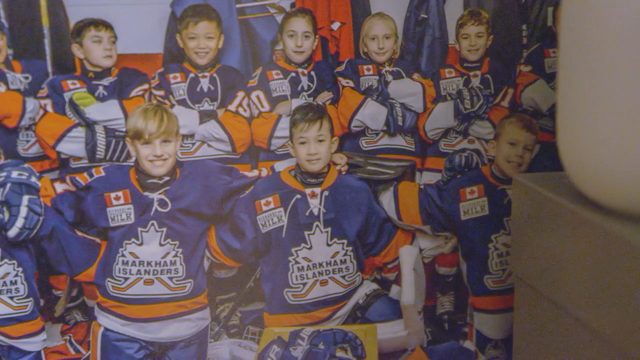
As Keenan’s title suggests, though, her importance to the organization goes beyond representing one community. Her impact comes from not just her perspective as a disabled fan of the game, but the intersection of all the different communities she is a part of, the different experiences that shape her understanding of the sport and its culture. It was in the spirit of this idea that her title was created — the term ‘intersectionality,’ coined three decades ago by Columbia and UCLA law professor Kimberlé Crenshaw, is grounded in the idea that our social identities overlap and intermingle. “It’s basically a lens, a prism, for seeing the way in which various forms of inequality often operate together and exacerbate each other,” Crenshaw said of the concept in 2020. For Keenan, then, her job is just as informed by her experiences as a woman of colour, and by every other facet of her journey. It’s with this understanding in mind that she’s taken a leading role with the team’s diversity, equity and inclusion committee, a group that features at least one representative from every department within the organization.
“We talk about everything from social and marketing to facilities operations to how we are recruiting and interviewing,” says Elliott. “And [ask], are those processes inclusive? Are they possibly limiting candidates? Anything like that. And I think Chanel has really taken a strong leadership role there of being really interested in the full spectrum of those issues and how they affect the business.”
Her reach has also extended into the wider Seattle community. Last year, Kyle Boyd — the Kraken’s director of fan development, and previously the club’s director of youth and community development — worked to build an extensive floor hockey curriculum for school districts in the region. The end result was a detailed 65-page guide equipping educators with all the information needed to bring floor hockey into elementary school physical education classes. Before it was sent for publication, Boyd brought it to Keenan to see if there were any gaps in the effort to make it an inclusive resource. “We had included a section for able-bodied youth to warm up, to get stretched and ready to play, but we had not included anything for those who might be using a wheelchair,” says Boyd. “And so we included, after connecting with Chanel, an adaptive warmup, and connected with a few folks in putting that together. It was great to have her be a part of this project and so many others where she can lend her voice and insight, and make sure that we are really thinking about all of our fans and all of our youth in the community, and not just some.”
Keenan and Boyd both understand the need to grow the game at the youth level in Seattle as it begins its journey at the pro level. Beyond the curriculum project, Keenan’s perspective has been crucial in ensuring that growth is inclusive for all newcomers to the sport. “We talked a little bit about who the play space is really built for and oftentimes who it isn’t for. And then how can we make sure that we’re putting in tips, suggestions, opportunities for youth who might be disabled to get into a sport like hockey, and making sure they know that there are so many opportunities,” Boyd says. “We talk a lot about how there are things like sled hockey, special hockey, blind hockey that we need to introduce early into a community and not have it be something that is introduced later or in the future. It’s important that young people and families know that they can get involved at a very early age.”
Suffice it to say, it’s been a busy 18 months for the 23-year-old, and much of that work has come a world away from her coworkers, primarily connecting virtually due in part to the pandemic and partly because Keenan lives on the opposite coast. When she did finally make the journey west to Seattle, though, to help the Kraken draft its first roster, her team at last got to give her a true sense of the change she’s been creating. “I think being able to have her there really helped show her the impact that she was having all across the organization, everyone knowing who she was and going to talk to her and recognizing her and knowing the work that she was doing,” says Elliott. “I think it’s hard to recognize and see the impact you’ve made until you get to see it in person. And I think it was pretty darn evident to her how much work she had done, and the respect the team had for her.”
For Keenan, the most important shift in understanding came not for herself but for her mom, Barbara, who made the trip to Seattle with her. “That was when it really clicked for her, as far as my impact, because it’s really hard to explain,” says Keenan. “It’s really complicated. I feel like those memes where millennials try to explain their jobs to their parents. And I would say it’s even harder to describe what I do for the Kraken because it’s a really innovative role. … Strictly through a disability and disabled-community lens, I feel like this is the first of its kind.
“But when we went out there and she saw everybody give me such a warm welcome, and just the natural engagement between myself and my coworkers, it was really impactful for her.”
It was more than just a simple lack of understanding that was overcome, though. It was the worry of where Keenan’s role might take her, how it might change her life back home. “I remember when we were leaving, we were in the airport and we had to wait a while for our flight, and I just asked her straight up, ‘Do you feel better now?’” Keenan recalls. “Because, you know, we’re all the way across the country in Boston, so to imagine the possibility of me moving out there one day, it’s hard. It’s hard for any parent, for your kid to move anywhere outside your home, but for it to be that far, and to consider all the other things that I have to account for, I can understand the hesitation.”
And yet, in making that journey to Seattle, in reading that name out in front of the thousands in attendance and the hundreds of thousands watching on TV, Keenan found more than enough to quiet any doubts about her path. “I got so many messages after the expansion draft … from people with disabilities and parents of kids with disabilities and what that meant for them — because they were not expecting that at all. And as a viewer, neither would I,” she says. “That showed me that, okay, this is important. Just stay. Even when things get really hard.”
It’s messages like those that fuel Keenan’s passion for growing this game. Not the praise, but the understanding that there are other hockey fans out there in the disabled community who similarly thought they would never see themselves represented in the sport, working for an NHL team or being part of an NHL broadcast. “I know I’m not the only one. I know there’s got to be a kid out there who has that dream,” she says. “And I think, for me, the reason why I didn’t think I’d ever get to where I am right now is because I saw not a single person that I could find that resembled me in this sport. … The reason I do all these things is to show someone out there — even if it’s just a parent of a child with a disability, I think that’s important too — for them to know that they could see their kid on TV. And not just in some inspirational hit piece about their lives, but as someone who can participate in something like this, as their job. That’s super important.
“We don’t see it enough. And I think there’s a lot of reasons why we don’t. We’re just not there, where it’s ‘normal’ yet. So that’s why I keep doing these things. To show them that.”
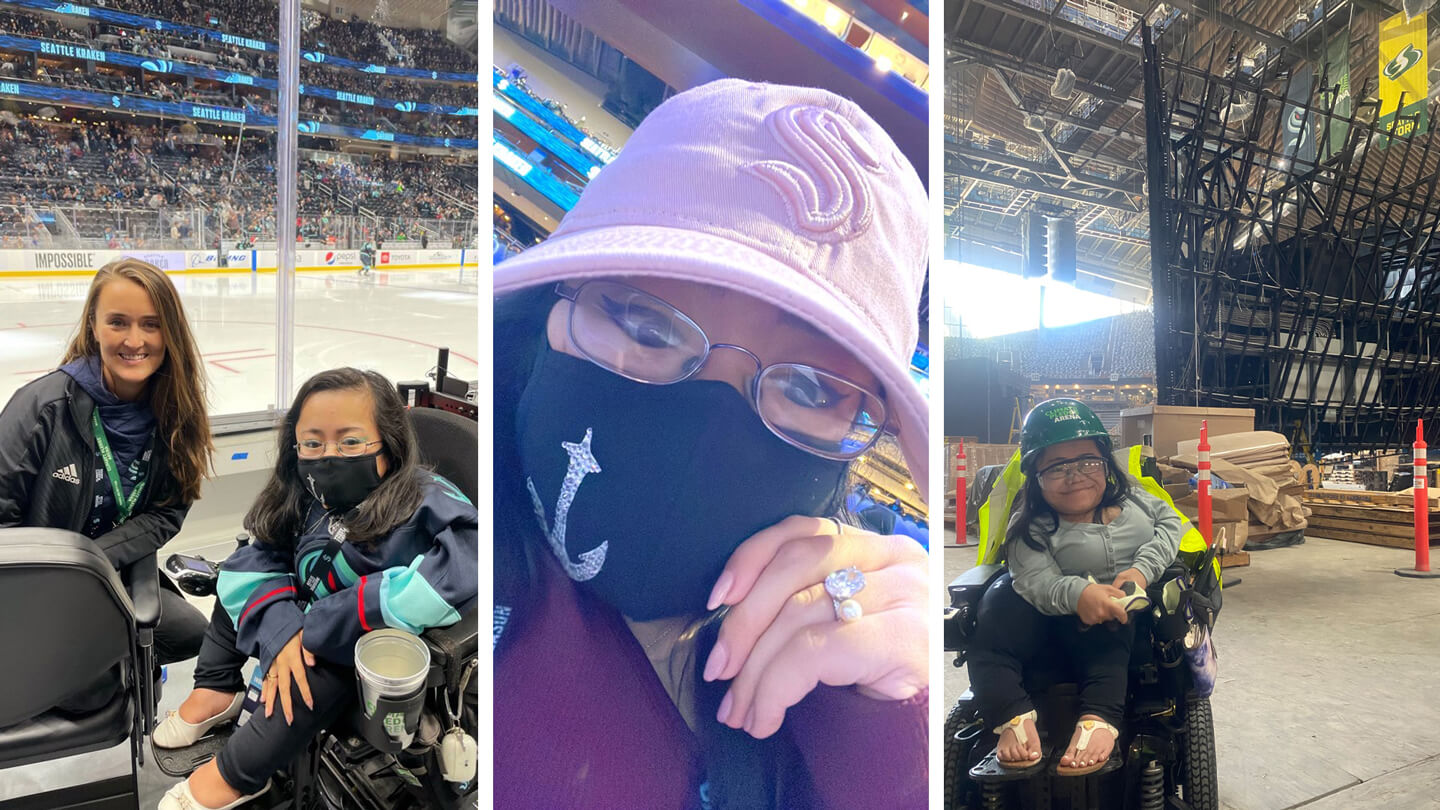
T
here’s a bracelet Keenan keeps on her wrist. Emblazoned across it are eight words from the second scene of the third act of A Midsummer Night’s Dream: “Though she be but little, she is fierce.” It’s one of a number of mantras Keenan returns to often, when her doubts swell like ocean waves and threaten to wash her away. “I do feel really small all the time. And I think that that’s really easy as a woman in this sport, to feel this way,” she says. “And then you factor in everything else that I have involved in my life, just my stature and my size alone, it’s really easy to make myself feel that way, even though it’s not necessarily true from a metaphorical standpoint.” She doesn’t look at the bracelet often, she says. Rather, it’s simply knowing the words are there. “It is a reminder to myself that things are happening. I just have to keep going. I have to start putting myself in uncomfortable situations,” she says. “It’s not about me — it’s about someone who can read [my story], relate to it, and then it changed their life. Which sounds really hyperbolic, and I can’t really imagine that scenario happening, but then I think about all the people I’ve been impacted by in a similar way. And then I just think that it’s possible.”
She doesn’t have to look far for such an example, as she’s been moved plenty by the story of another Boston changemaker, Willie O’Ree. Watching a recent documentary about the Bruins legend revived those feelings of awe in her, that respect for all O’Ree battled through and the immense importance of his decision to do so. “There was so much that Willie was going through, and he still persevered, and he still broke barriers,” she says. “And he was doing it in a time that wasn’t ready for him yet.”
In some ways, Keenan says, it feels as though she is too. Despite the fact that there have been people with disabilities for as long as there have been people, the disabled community still finds itself misunderstood, misrepresented, missing from the conversation. In the hockey world, the reason seems simple enough — we’ve rarely seen disabled bodies celebrated in the game, aside from the overplayed hand of perseverance narratives. “We’re not seeing it in our spaces, that we can really put ourselves in that mindset or in that position,” Keenan says. “I think the hardest part for me was that there was no clear path in how to do this. So that’s what I keep in the back of my mind — I’m building this blueprint for someone else. That’s what’s important to me, to make sure that I’m doing this properly … to give someone else the vehicle and the ability to take the path that I did.”
It also goes beyond the sports world. The heart of the issue lies in how our wider culture conceptualizes disability. In what we choose to celebrate and what we choose to gawk at, what we choose to discuss and where we choose to remain silent. In the piece Keenan wrote back in 2020, the one that served as the catalyst for her Seattle journey, she describes her dream of a hockey commercial that features a family sitting together watching a game, some of them on the couch, one in a wheelchair, sticky tires on a wooden floor. The commercial wouldn’t be about perseverance or hardship, nor would it depict a world in which disability is absent. It would simply be about hockey, and the people who love it. “That single commercial would change my life,” she wrote back then.
Reflecting on it now, she considers why we still haven’t seen that depiction. “I think about how I’ll do things in everyday life and people will gawk at it, and be like, ‘Whoa, a disabled person can go to the grocery store?’ Or ‘They can go to a bar, and have a good time?’ There’s so many little weird things that happen when I’m out in public,” she says. “These same stories that a lot of my friends go through as well, where they’ll go somewhere that’s not where you would think a disabled person would go to, whether it be a nightclub or something else. … Why is it so weird for people to see disabled people ‘in the wild’ having a great time? I think it’s just because they can’t even see a commercial and see that represented, you know? You can’t even do it for food? We eat food!”
There’s no discussing Keenan’s current role without understanding that this is the starting point. For each new conversation she encourages and each moment of representation she embodies, the distance that must be traversed begins from this erasure, this place where disability is not simply pushed to the background, but absent. Where it’s not just a question of ‘more,’ but one of ‘at all.’
The hope, though, is that through her work, she can plant the seeds. That she can create in the hockey world an environment in which respect and understanding for the disabled community can bloom. Even if the path to getting there seems daunting.
“I’m trying to leave it better than I found it,” Keenan says. “It would be easier to walk away, 100 per cent. Every day, some time, I think about it. It would be easier. … But, you know, I’m reminding myself that even though it’s hard right now, and it will be in the future, just stay.
“Just try to water all these plants at the same time, and eventually, hopefully, there will be something beautiful here.”
Design by Drew Lesiuczok. All photos courtesy of Chanel Keenan.





